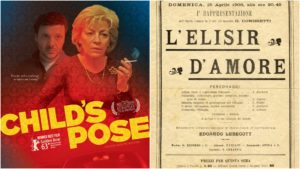
Opera Meets Film: Leontina Vaduva’s Important Cameo in ‘Child’s Pose’
By David Salazar“Opera Meets Film” is a feature dedicated to exploring the way that opera has been employed in cinema. We will select a section or a film in its entirety, highlighting the impact that utilizing the operatic form or sections from an opera can alter our perception of a film that we are viewing. This week’s installment features Calin Peter Netzer’s “Child’s Pose.”
Soprano Leontina Vaduva makes a notable appearance in the Romanian film “Child’s Pose,” as herself and as such appears in two separate scenes early in the film.
We first encounter the famed soprano during the film’s opening sequence at the birthday party of Cornelia, the film’s protagonist. Vaduva is introduced as herself at the table among the high society socialites depicted in the film. That the film’s protagonist (played by Luminita Gheorghiu) is surrounded by a number of major members of Romanian society, including one of its famed opera stars of recent years, emphasizes her prominence in this social world.
This is furthered a few scenes later when we see Cornelia as an audience member for one of Vaduva’s masterclasses. Here we see the famed soprano not only as a teacher but also as an artist.
The two young artists are engaged in the second duet, “Esulti pur la barbara,” between Nemorino and Adina from “L’Elisir d’Amore.” This duet features Nemorino confident of winning Adina after drinking the famed Elisir, setting off a flirtation between the two. In the immediate aftermath of the duet, the two find themselves further away than ever before; but eventually they find a way to reconnect by the opera’s end. Throughout, Vaduva is shown spurring the singers on and even doing some of her own singing and acting to support the soprano in the scene.
Director Calin Peter Netzer actually lingers on the scene for quite some time and what’s more, he doesn’t actually show Cornelia aside from a shot that establishes her in the space. It isn’t until the end of the scene that we return to her.
The choice of opera actually mirrors the main narrative thread of “Child’s Pose,” which follows Cornelia trying to reconnect with her son throughout the story after he has a car accident that kills a child. Throughout the film, Cornelia finds her relationship with her son increasingly challenging, the two striking a tenuous compromise at the film’s end.
In some way, the “cat and mouse” game that transpires throughout the film, albeit in a tragic dimension, is reflected in Nemorino’s own pursuit of Adina. It is worth noting that the duet directly precedes the inciting incident where Cornelia finds out about her son’s car accident. Prior to this, the tone of the film has retained a rather relaxed ambience that jumps from Cornelia’s birthday party to a private scene and then to the masterclass itself. To this point, the tragic dimensions of the story are nowhere to be seen and the opera duet undeniably keeps things light and the audience somewhat misdirected.
However, the film’s tragic element converges on this very scene. As the duet draws to a close with the vocal union of the two singers during the cadenza of the duet, the camera abruptly zooms into a shot of Olga, one of Cornelia’s close relations, entering the space. Even if the singing doesn’t stop, the visual moment disrupts the entire flow of the scene and suddenly alters the entire emotional landscape of the moment.
After this, the film will retain a darkness and tragic tone, the “Elisir” duet but a distant memory.


